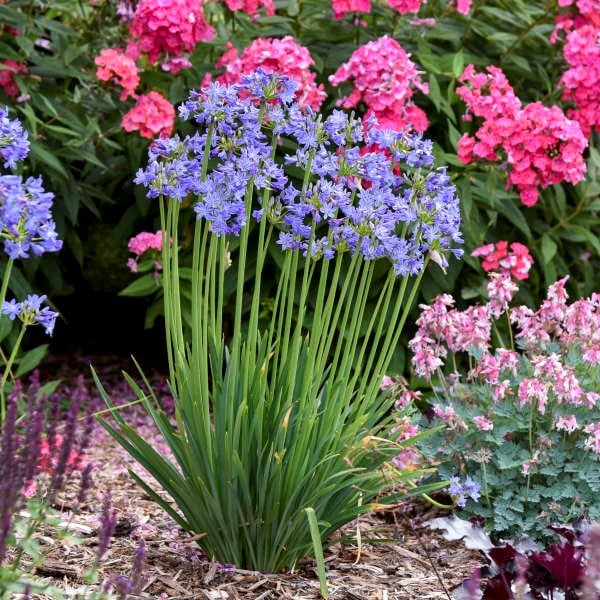Unleashing the Secret to Effective Agapanthus Farming: Advice for a Flourishing Yard
In the world of gardening, cultivating agapanthus effectively requires a strategic approach that encompasses different aspects of plant care. By recognizing the subtleties of agapanthus cultivation, one can create an environment where these plants flourish and flower abundantly.
Planting Agapanthus: Ideal Practices
When growing Agapanthus, appropriate dirt preparation is essential for making sure successful growth and growth of these stunning blossoms. Agapanthus, frequently known as Lily of the Nile or African lily, flourishes in well-draining dirt with a somewhat acidic to neutral pH degree - Agapanthus. Prior to growing, it is crucial to modify heavy clay soils with raw material such as compost or peat moss to boost drainage and provide important nutrients for the plants
To plant Agapanthus, choose a location that receives complete sunshine to partial color, as this will certainly advertise healthy growth and bountiful flowering. Dig an opening two times the diameter of the plant's root round and put the Agapanthus at the same deepness it was previously growing. Carefully backfill the opening with soil, pushing down strongly to remove any air pockets around the origins.
Water the freshly planted Agapanthus thoroughly and proceed to keep the dirt equally damp, especially during the plant's energetic expanding period. Agapanthus. Using a well balanced fertilizer once a month can better support the plant's development and blooming. By following these finest practices for planting Agapanthus, you can develop a magnificent display of these captivating blossoms in your yard
Perfect Soil Conditions for Agapanthus
For optimal development and flowering success of Agapanthus plants, making sure the dirt problems are suitable is crucial. Agapanthus chooses soil that is rich in nutrients, so including a well balanced plant food during the growing season can promote healthy and balanced development and dynamic blossoms.
:strip_icc()/agapanthus-africanus-b959396b-5696f86e059c46f299d1834ba687c6eb.jpg)
Watering and Feeding Tips
To make certain healthy and balanced development and vivid blossoms, proper watering and fertilizing techniques are essential for successful Agapanthus cultivation. Agapanthus plants profit from regular watering, particularly during the go to this web-site growing season.
When it concerns feeding Agapanthus, a well balanced fertilizer with equal components nitrogen, phosphorus, and potassium can be used in the springtime to advertise healthy growth and blooming. Slow-release fertilizers are suitable for offering nutrients gradually over a prolonged duration. Avoid over-fertilizing, as this can lead to too much foliage growth at the expense of flowers.
Additionally, including natural matter like garden compost into the dirt can enhance nutrient levels and improve dirt structure, aiding in the overall health and wellness of the Agapanthus plants. By following these watering and feeding tips, gardeners can ensure their Agapanthus plants prosper and produce magnificent display screens of blossoms.
Pruning and Deadheading Techniques
Appropriate trimming and deadheading methods play a critical duty over at this website in maintaining the wellness and aesthetic appeals of Agapanthus plants, complementing the necessary practices of watering and feeding for successful cultivation. Pruning Agapanthus involves getting rid of invested blossom heads, dead or yellowing fallen leaves, and total shaping of the plant to promote much better development. Deadheading, the procedure of getting rid of discolored blossoms, not just enhances the plant's appearance but additionally encourages additional blooming.
When deadheading Agapanthus, it is advisable to clip off the blossom stem at the base making use of sharp, tidy shears. This process redirects the plant's energy from seed production back right into root and foliage growth, advertising a healthier and a lot more robust plant. Regular deadheading can prolong the blooming duration of Agapanthus and prevent self-seeding, which can bring about congestion.
In terms of pruning, Agapanthus usually benefits from a light trim after blooming to clean the plant and motivate fresh growth. Cutting down the spent blossom stems and eliminating any type of broken or dead foliage helps keep the plant's vitality and total appearance. However, it is necessary to stay clear of reducing right into the crown of the plant, as this can deteriorate its health.

Protecting Agapanthus From Pests and Diseases
Executing reliable bug and disease management methods is vital to securing the health and wellness and vitality of Agapanthus plants in farming. One usual pest that influences Agapanthus is the Agapanthus borer, a caterpillar that tunnels into the plant, causing damage to the blossoms and fallen leaves.
In addition to insects, Agapanthus are vulnerable to illness such as origin rot and fungal leaf spots. By remaining vigilant and resolving bug and disease concerns quickly, gardeners can assist their Agapanthus thrive and flourish.

Verdict
Finally, effective cultivation of agapanthus needs proper growing methods, ideal visit our website soil conditions, appropriate watering and fertilizing, regular trimming and deadheading, and defense from illness and parasites. By following these suggestions and tricks, garden enthusiasts can make certain a prospering garden filled with beautiful agapanthus blossoms. Agapanthus. Bear in mind to keep consistent treatment and focus to information to promote the health and long life of these stunning plants
When growing Agapanthus, correct dirt prep work is essential for ensuring successful growth and advancement of these gorgeous blossoms.Water the freshly planted Agapanthus extensively and proceed to keep the dirt evenly wet, specifically throughout the plant's active growing period.For optimal development and blooming success of Agapanthus plants, making certain the dirt problems are excellent is essential. When planting or hair transplanting Agapanthus, make certain the soil is well-prepared to give the essential foundation for the plants to develop themselves effectively. One usual parasite that affects Agapanthus is the Agapanthus borer, a caterpillar that tunnels right into the plant, causing damages to the flowers and fallen leaves.